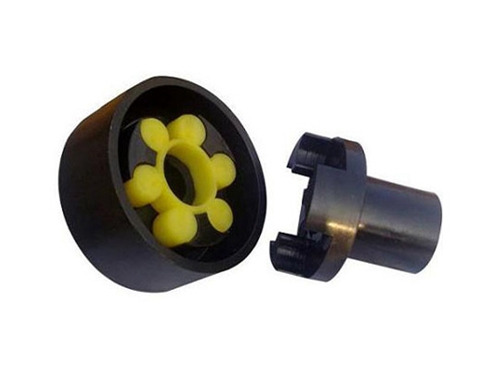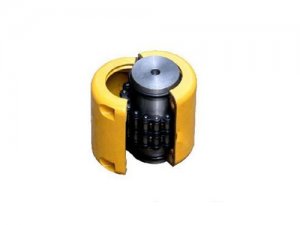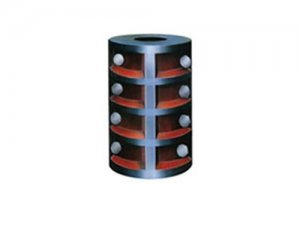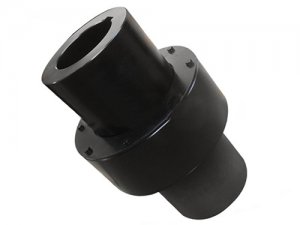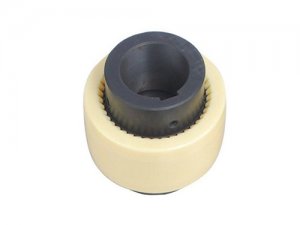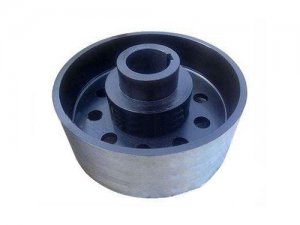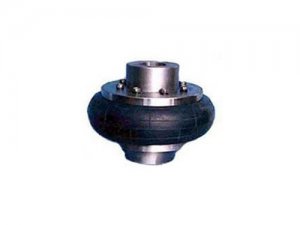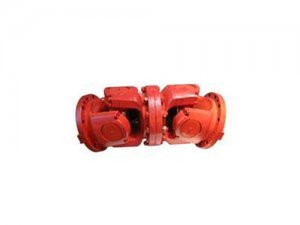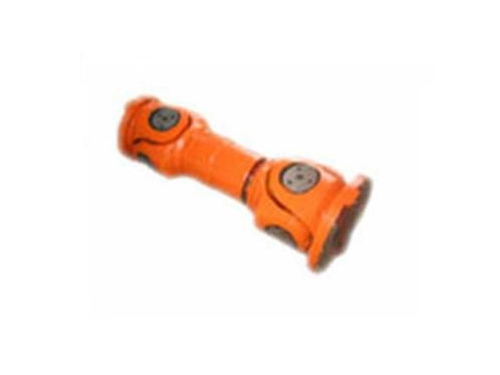
-
product name:
-
product description:SWCBF Standard Telescopic Flange Coupling Purpose: Used to connect two shafts (driving shaft and driven shaft) in different mechanisms to make them common..
-
Related tags:
SWCBF standard telescopic flange coupling due to various reasons makes its center of mass or inertial main axis do not coincide with the axis of rotation, and it will produce unbalanced centrifugal inertial force, centrifugal inertial couple force and dynamic deflection (vibration shape) during operation. , Known as the unbalance phenomenon of the rotor, this unbalance phenomenon will inevitably cause the vibration of the shaft system, thereby affecting the normal operation and service life of the machine, so it should be paid attention to.The degree of unbalance (unbalance U) is usually expressed by the product mr of the mass m of the rotor and the distance r from the center of mass to the axis of rotation of the rotor, which is called the product of mass diameter.It is also expressed by the product of mass diameter per unit mass, called eccentricity (not geometrically eccentric.) The product of mass diameter mr is a relative quantity related to the mass of the rotor, while the eccentricity e is independent of the mass of the rotor. the amount.The former is relatively intuitive, and is often used for specific balancing operations of a given rotor. The latter is used to measure the pros and cons of the rotor balance or to detect the balance accuracy. The balance grade standard of the coupling is evaluated by e.For a flexible rotor, use the mode eccentricity (the nth mode) en=Un/mn, and Un and mn are the nth mode and the first mode quality respectively.
SWCBF Standard Telescopic Flange Coupling Purpose: Used to connect two shafts (active shaft and driven shaft) in different mechanisms to make them rotate together to transmit torque mechanical parts. In high-speed and heavy-duty power transmission, Some couplings also have the function of buffering, damping and improving the dynamic performance of the shafting.The coupling is composed of two halves, which are respectively connected with the driving shaft and the driven shaft.The general power machine is mostly connected with the working machine by means of a coupling.
Coupling selection requirements:
According to the characteristics of the model and the operation of the system, select the appropriate coupling form:
1. Torque
The torque of the coupling should be twice the transmission torque. For example, if the transmission torque value is 5 (NM), a coupling with a torque value of 10 (N.,) should be selected. The material should be rigid torque.
2. Flexible/rigid
Flexible couplings can absorb parallel deviation, angular bottom deviation, and axial displacement. High-rigidity couplings do not, so the accuracy of the shaft end is very high.
3. Applicable occasions-high and low temperature. Acid...
Choose the material of the coupling, whether it can load acid, high and low temperature occasions.
4. With or without backlash
5. Insulation
6. Be vibrating
7. Tolerable speed
8. Has the ability to protect the machine
9. Is the aperture range applicable?
| Model | Project | SWC 160 | SWC 180 | SWC 200 | SWC 225 | SWC 250 | SWC 265 | SWC 285 | SWC 315 | SWC 350 | SWC 390 | SWC 440 | SWC 490 | SWC 550 | SWC 620 |
| A type | L | 740 | 800 | 900 | 1000 | 1060 | 1120 | 1270 | 1390 | 1520 | 1530 | 1690 | 1850 | 2060 | 2280 |
| Lv | 100 | 100 | 120 | 140 | 140 | 140 | 140 | 140 | 150 | 170 | 190 | 190 | 240 | 250 | |
| m(kg) | 65 | 83 | 115 | 152 | 219 | 260 | 311 | 432 | 610 | 804 | 1122 | 1468 | 2154 | 2830 | |
| Type B | L | 480 | 530 | 590 | 640 | 730 | 790 | 840 | 930 | 1000 | 1010 | 1130 | 1240 | 1400 | 1520 |
| m(kg) | 44 | 60 | 85 | 110 | 160 | 180 | 226 | 320 | 440 | 590 | 820 | 1090 | 1560 | 2100 | |
| Type C | L | 380 | 420 | 440 | 500 | 560 | 600 | 640 | 720 | 780 | 860 | 960 | 1080 | 1220 | 1560 |
| m(kg) | 35 | 48 | 66 | 90 | 130 | 160 | 189 | 270 | 355 | 510 | 690 | 970 | 1330 | 1865 | |
| Type D | L | 520 | 580 | 620 | 690 | 760 | 810 | 860 | 970 | 1030 | 1120 | 1230 | 1360 | 1550 | 1720 |
| m(kg) | 48 | 65 | 90 | 120 | 173 | 220 | 250 | 355 | 485 | 665 | 920 | 1240 | 1765 | 2390 | |
| And 型 | L | 800 | 850 | 940 | 1050 | 1120 | 1180 | 1320 | 1440 | 1550 | 1710 | 1880 | 2050 | 2310 | 2540 |
| LV | 100 | 100 | 120 | 140 | 140 | 140 | 140 | 140 | 150 | 170 | 190 | 190 | 240 | 250 | |
| m(kg) | 70 | 92 | 126 | 168 | 238 | 280 | 340 | 472 | 660 | 886 | 1230 | 1625 | 2368 | 3135 | |
| Tn | kN*m | 18 | 25 | 35.5 | 40 | 63 | 80 | 90 | 125 | 180 | 250 | 355 | 500 | 710 | 1000 |
| Tf | kN*m | 9 | 12.5 | 18 | 20 | 31.5 | 40 | 45 | 63 | 90 | 125 | 180 | 250 | 355 | 500 |
| β | ° | 15 | 15 | 15 | 15 | 15 | 15 | 15 | 15 | 15 | 15 | 15 | 15 | 15 | 15 |
| D | 160 | 180 | 200 | 225 | 250 | 265 | 285 | 315 | 350 | 390 | 440 | 490 | 550 | 620 | |
| Df | 160 | 180 | 200 | 225 | 250 | 265 | 285 | 315 | 350 | 390 | 440 | 490 | 550 | 620 | |
| D1 | 137 | 155 | 170 | 196 | 218 | 233 | 245 | 280 | 310 | 345 | 390 | 435 | 492 | 555 | |
| D2(H9) | 100 | 105 | 120 | 135 | 150 | 160 | 170 | 185 | 210 | 235 | 255 | 275 | 320 | 380 | |
| D3×δ | 114 × 11 | 127 × 12 | 146 × 13 | 159 × 12 | 180 × 14 | 194 × 15 | 203 × 16 | 219 × 19 | 245 × 22 | 273 × 25 | 325 × 25 | 351 × 30 | 402 × 32 | 426 × 40 | |
| Lm | 95 | 105 | 110 | 125 | 140 | 150 | 160 | 180 | 195 | 215 | 240 | 270 | 305 | 340 | |
| K | 16 | 17 | 18 | 20 | 25 | 25 | 27 | 32 | 35 | 40 | 42 | 47 | 50 | 55 | |
| t | 4 | 5 | 5 | 5 | 6 | 6 | 7 | 8 | 8 | 8 | 10 | 12 | 12 | 12 | |
| n | 8 | 8 | 8 | 8 | 8 | 8 | 8 | 10 | 10 | 10 | 16 | 16 | 16 | 16 | |
| d | 15 | 17 | 17 | 17 | 19 | 19 | 21 | 23 | 23 | 25 | 28 | 31 | 31 | 38 | |
| b | 20 | 24 | 28 | 32 | 40 | 40 | 40 | 40 | 50 | 70 | 80 | 90 | 100 | 100 | |
| g | 6.0 | 7.0 | 8.0 | 9.0 | 12.5 | 12.5 | 15.0 | 15.0 | 16.0 | 18.0 | 20.0 | 22.5 | 22.5 | 25 | |
| mL | kg | 2.80 | 3.40 | 4.26 | 4.35 | 5.73 | 6.62 | 7.38 | 9.37 | 12.10 | 15.29 | 18.50 | 23.75 | 29.12 | 38.08 |
| Flange bolt | specification | M14 | M16 | M16 | M16 | M18 | M18 | M20 | M22 | M22 | M24 | M27 | M30 | M30 | M36 |
| Tightening torque (N*m) | 180 | 270 | 270 | 270 | 372 | 372 | 526 | 710 | 710 | 906 | 1340 | 1820 | 1820 | 3170 | |
Company News
News

Copyright © 2017-2018 Hengli Transmission All Right Reserved.



